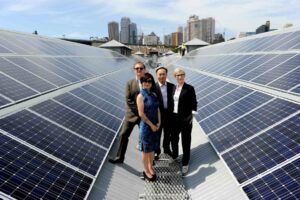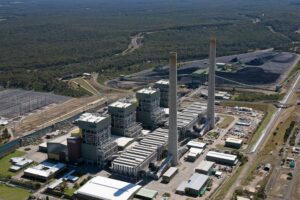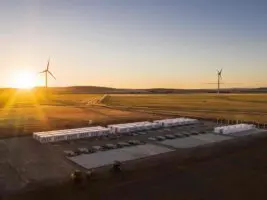Here’s a question that may appear in a trivia night near you sometime soon, so it’s a good idea to get ready.
Name something that is worse than useless: One sure answer will be the National Energy Guarantee, particularly as framed under the federal government’s emissions reduction target.

State ministers on Friday gave the “amber” light for the Energy Security Board to continue work on its design of the NEG – and its so-called emissions and reliability obligations – despite big reservations about the scale of ambition which will be set by the federal government.
Many have said that the emissions reductions assumed under the NEG for the electricity sector – 26 per cent by 2030 – will be worse than business as usual, and criticise the government’s decision to seek only a “pro-rata” goal for the electricity sector.
But it is much, much worse than that.
New analysis from Owen Kelp, one of the principals of ACIL Allen, a leading energy consultancy that has not always been seen as a friend to renewables, suggests the NEG is assuming that electricity only achieves 5 per cent of Australia’s overall emissions reduction target by 2030.
How is this so? Kelp argues that Australia’s emissions should be seen as a “budget”, rather than a number achieved in a particular year.
Australia is happy to use this when declaring it has met its Kyoto targets, but in a sleight of hand has sought to paint its 2030 target under the Paris agreement as an annual goal, rather than an overall budget.
Kelp explains his calculations and the implications, in more detail here. But it underlines a critical point – the NEG is being used by the government as a deliberate attempt to put the brakes on the clean energy transition.
This is ironic, because the energy institutions within the ESB have clearly realised that the clean energy transition is not just feasible, but desirable, from the perspective of costs, emissions, reliability and investment.
And it poses another issue that the government has so far refused to address, but which is now appearing to bubble away in the background:
If virtually no emissions reductions are to be obtained from electricity – despite its ability to gain the cheapest and easiest abatement – then how is the government ever going to meet its Paris target, and which sector is going to have to carry the burden?
Deputy prime minister and national leader Michael McCormack raised this issue in Canberra on Thursday, at a National Press Club event, saying he did not want to see the onus fall on to the transport sector, which in any case will struggle to achieve emissions reductions without a big switch to electric vehicles, and a renewables dominated grid, particularly when even the lightest emissions standards are dismissed as a carbon tax and quickly abandoned.
It also begs another question. The NEG’s promised price reductions are based largely on the results of the renewable energy target, with the new investment likely to cause two-thirds of the reductions assumed under the modelling.
The rest of the price reductions are based on the NEG requiring more renewables to be built. But all new private analysis, almost unanimously, suggests that the NEG will not cause new renewable energy investment to be made.
But federal energy and environment minister Josh Frydenberg marches on.
“The intention is to lock into legislation the 26 per cent recuction in emissions,” he said on Friday. “We propose no change out to 2030.”
He also signalled no change on offsets, another major sticking point. A tonne in India is the same as a tonne abated in Australia, he said. Maybe, but it does not result in the same local investment.
The result of this, of course, is that the government policy would cause no new renewable energy investments in the decade from 2020-2030 – the industry would have to rely entirely on the household market, the corporate market, and state-based schemes.
Some bigger electricity retailers may also be encouraged to invest in renewables if they have to close down their coal-fired generators, such as AGL in 2022 and Origin by 2032 – although Frydenberg stressed again today that his government was not in any hurry to usher out coal power.
“There’s a lot of life left in them,” Frydenberg said of the country’s 20 coal generators. “Coal has good chance to play vital roll in system. We should not be demonising coal.”
As for renewables, for the meantime it looks like investment will fall off a cliff.
Mark Butler, the Labor spokesman on energy and climate, repeated his stance that Labor will “simply not agree to locking in a decade of inaction just because Malcolm Turnbull won’t stand up to Tony Abbott and his merry band of climate change deniers in the Coalition party room.”
One of those climate deniers, Craig Kelly, who speaks on energy on behalf of the Coalition back-bench, continued his opposition, saying the NEG would still force “otherwise uneconomic renewables into the grid.”
“If renewables are the cheapest, the market will adopted (sic) them and no one would use coal or gas because it’s more expensive,” he said in an email to a RenewEconomy reader.
“But the truth is, claims that ‘renewables are the cheapest’’ is just a complete deception – a lie if you like. For you can’t compare the price of intermittent electricity generation with 24/7 dispatchable generation – they are not the same product, they are not interchangeable.
“But that has never stopped those riding the gravy train, and pocketing billions in subsidies, from spreading lies to an often gullible unthinking audience, that want to believe.”
The deadlock over emissions means that Australia is no closer to bipartisan policy on energy and climate than it has ever been.
Because of the ESB reassessment on the reliability obligation, which will likely never be triggered, and the weak emissions target, which means the emissions obligation will never be triggered, then there is little to show for this policy.
Emma Herd, the head of the Investor Group on Climate Change, said investors, energy companies and business groups have all acknowledged that the level of ambition under the National Energy Guarantee can and should be increased.
“Unless the emissions reduction target is increased under the National Energy Guarantee, the policy risks failing to address investment uncertainty.”
In New South Wales, the acting premier John Barilaro, has been quoted as saying that the government should nationalise key assets such as the Liddell power station, and back a potential push into his favourite technology, nuclear energy.
It signals that Australia is lurching further to the right, and getting closer to the Trump administration policy, which is being openly directed by a series of key appointees who are openly hostile to climate science and renewables.
The latest proposal there is for the US government to re-invoke a war-time measure that required government support to ensure power generators stayed on. It is being used to add more subsidies to loss-making coal generators and nuclear plants.
In Australia, the Labor states are still hopeful of a change in federal government policy, and have suggested that this will be a condition of its final approval of the NEG, but this is unlikely to occur.
Victoria has also posed a list of questions it wants answered about the functioning of the NEG, as well as the emissions reductions target.
It denied reports it already waived its demand for “additionally” for its own target. Incorporating individual targets under the federal target means the likes of NSW, with no renewable incentives, will need to do even less because of the high targets in Victoria and Queensland.
Despite the positioning, the COAG meeting did what it was always expected to do: give approval for further work to be done on the detailed design of the mechanics of the NEG.
The ESB will do further work on the design of the policy – which is already much improved from the version presented last November. A COAG energy ministers phone hook up will take place in June, with a meeting on the final design scheduled for August.
The big issues – that of ambition, or actually facilitating the clean energy transition that the ESB now concedes is the key to a cleaner, cheaper and more reliable grid – have been put off until August.
Note: This story has been update to include Victoria’s rejection of suggestions it had abandoned its push for “additionally” of state-based targets.








